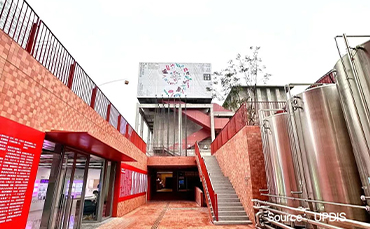


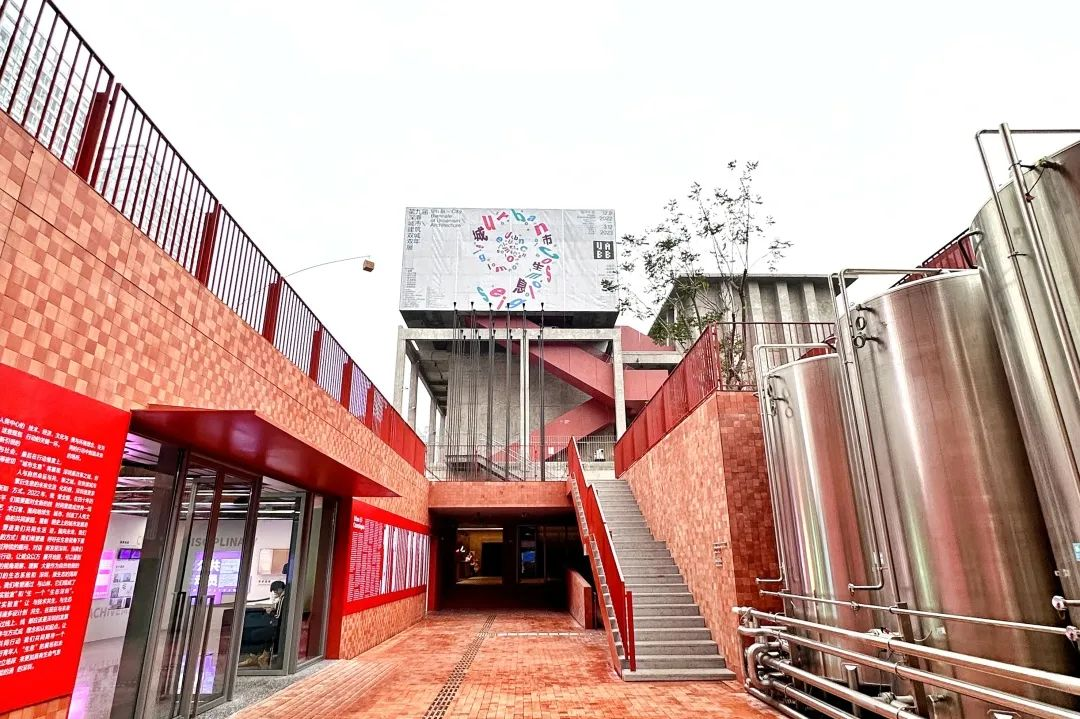
Source: Shenzhen Urban Planning and Design Institute
1. The Jinwei Brewery:The epitome of the proposition of protection and development in urban renewal.
1.1 Urban memory and increasingly constrained urban space.
In 1990, Shenzhen Beer Co., LTD., built a 5-story circular building with golden glass in Luohu District and named it Jinwei Restaurant. In the same year, the first Jinwei beer was also produced in Luohu. After its launch, Jinwei beer was in short supply, and its sales once occupied 70%-80% of the market share in Shenzhen, and more factories were built one after another. Eating oysters and drinking beer in Jinwei Beer Square became the fashion of Shenzhen people at that time.It can be said that Jinwei recorded the youth of Shenzhen's old generation of pioneers. As a famous local beer brand in Shenzhen, Jinwei Beer has engraved passionate memories for this young city.
However, since 2007, corporate profit has declined year by year due to market changes. By 2012, Jinwei Brewery's production business had suffered serious loss so that the company eventually chose to sell the beer business as a whole. The severe reality forces the enterprise to choose to introduce new industries through urban renewal in order to achieve upgrading and sustainable development of the enterprise. Jinwei Brewery was included in the Shenzhen Urban Renewal Unit Plan in 2012, which plans to build a new industrial and business district after demolition.
Since the reform and opening up, the rapid development of urban construction in Shenzhen has been confronted with the situation of tight constraints on land resources. Industrial development also continues to iterate and upgrade, and there is a strong demand for space. In order to actively revitalize stock resources and improve land use efficiency, urban renewal oriented to built-up areas has become an important way to expand urban development space in Shenzhen. Shenzhen's urban renewal work has been promoted rapidly from 2009, and a large number of old industrial zones have been renovated, effectively enhancing the vitality of urban industries and promoting industrial transformation and upgrading. However, most of the early projects took the way of demolition and reconstruction, and the urban memory rooted in the old city space was difficult to retain. In the process of urban renewal, how to preserve the original urban memory and integrate it into the new urban space and urban function has become one of the focuses of urban renewal work.
1.2 Conservation dilemma of ungraded historic industrial buildings.
The renovation of Jinwei Brewery has attracted attention from many Shenzhen citizens. Although the Jinwei Brewery meet the conditions of demolition and reconstruction at that time, the unique beer production structures in the factory have the preservation value of urban memory and culture. However, these historic industrial buildings are not graded, and a series of issues such as how to determine the value of these buildings, whether to protect them, and how to protect them are very vague. The public wants to preserve the memory of Jinwei Brewery, the government wants to comprehensively evaluate the development benefits and the cultural value of the city, and the capital wants to expand the space for new industries as much as possible.There is no consensus among stakeholders on the ways and means of urban renewal.
In 2012, Shenzhen Urban Plan and Design Institute was commissioned to carry out the "Urban renewal unit Plan of Jinwei Brewery in Dongxiao Street, Luohu District", which focuses on the continuation of urban memory and culture in urban renewal, explores the protection mechanism of historical industrial buildings under the market mechanism, and becomes a demonstration project of organic renewal in Shenzhen.
The project team is deeply aware that the transformation and upgrading of Jinwei Brewery is an inevitable requirement for the sustainable development. At the same time, considering the beautiful life memory it brings and the continuation of urban culture, the protection of historical industrial buildings is an important issue in the plan. Aiming at the two core propositions of industrial development and cultural protection, the renewal unit plan establishes a consultation platform to promote multi-party consensus, proposes the overall idea of urban renewal that takes into account industrial transformation and upgrading as well as the protection and utilization of historical industrial buildings, innovates the planning scheme and implementation mechanism, and carries out the renewal and transformation through the organic renewal method of "demolition and reconstruction + protection of industrial relics".
2. Urban renewal unit Plan of Jinwei Brewery:exploration of historical industrial building protection under market-oriented mechanism.
2.1 Change of idea:taking urban renewal unit planning as a negotiation platform to form a plan that combines protection and development.
In order to coordinate the demands of multiple stakeholders , the project adopted an open planning method, organized several seminars of government departments and experts, and held a design workshop for the society. After more than 10 rounds of discussion, on the basis of extensive consultation and discussion, the scope of protection of industrial heritage is proposed.The urban renewal strategies that take into account industrial transformation and protection and utilization of industrial heritage are proposed.
2.2 Space design:shaping a new industrial space that integrates urban memory.
In terms of space design, the scheme rearranges and excavates the industrial elements with historical preservation value of Jinwei Brewery, and adopts different protection methods to formulate protection and utilization schemes for different industrial elements. The construction structures such as beer fermenter groups with distinctive characteristics and high cultural value shall be classified into the transferred land for public interest for permanent retention; For the filling workshop with good preservation status and greater use value, although it is classified within the scope of demolition and reconstruction, the plan requires retention and renovation. For some equipment and structures with certain characteristics, such as pipelines, the plan proposes to design it as a characteristic industrial element to relocate and retain with architectural design.
At the same time, the plan incorporates the spatial requirements of the new industry into the preserved buildings. In terms of functional layout, combined with the reserved area of industrial buildings, the theme activity areas such as industrial culture creative block and beer culture square are planned. In terms of architectural use, the original fermenter groups are used to build beer culture museums, conferences, exhibition venues, etc.
In this scheme, the preservation of the building provides material space and cultural brand benefits at the same time, and exerts new value in the industrial transformation: the exhibition area and the cultural block can become a distinctive venue, while the old people's feelings for "Jinwei" and the new people's interest in "industrial transformation" make the place more attractive.
2.3 Means of balancing interests:exploring the incentive mechanism for preserving historical buildings.
In the urban renewal work under the market-oriented mechanism, it is necessary to realize that the market has its own operation laws, and whether the economic calculation of the project can achieve balance directly determines whether the project can be landed, and also greatly affects the intensity and effect of the protection of historical industrial buildings.
The urban renewal unit plan of Jinwei Brewery actively explores the market-oriented implementation mechanism for the protection of historical industrial buildings. In order to arouse the enthusiasm of enterprises for protection, the project proposes creative measures to reward the protection of historic buildings. For the first time, the project proposed the planning volume calculation method of returning 1.5 times the floor area according to the sum of the floor area of the retained building and the projected area of the retained structure, providing volume incentives for the market players, stimulating the enthusiasm of the market players for the protection of historical buildings, and thus promoting the implementation of the project.
3. Conclusion.
Today, the renovated Jinwei Brewery has become a cultural card and a representative case of urban renewal. It not only serves the urban development and industrial upgrading, but also retains the urban memory of the citizens. We hope that by practicing the concept and method of organic renewal like embroidery, the memory of people's life and work will not disappear with the development of the city.The struggling generation can see their memories grow together with the city, and look forward to adding color to the memory of the city through the guidance of urban events with continuous careful operation.
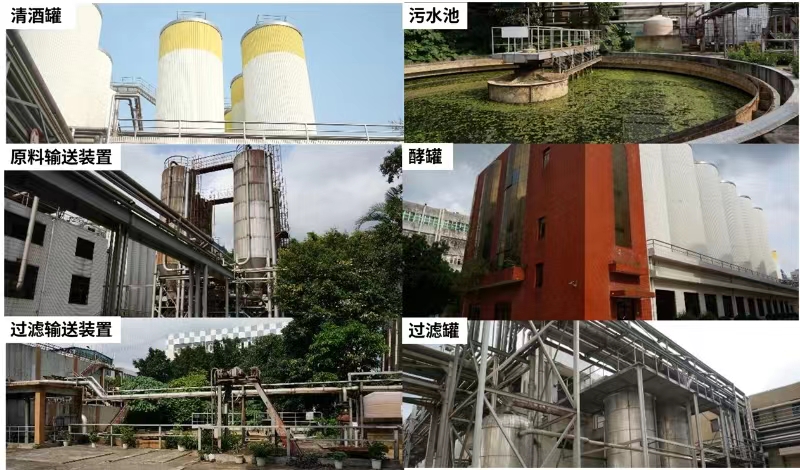
The industrial buildings and equipment planning to retained [Source:Shenzhen Urban Planning and Design Institute]
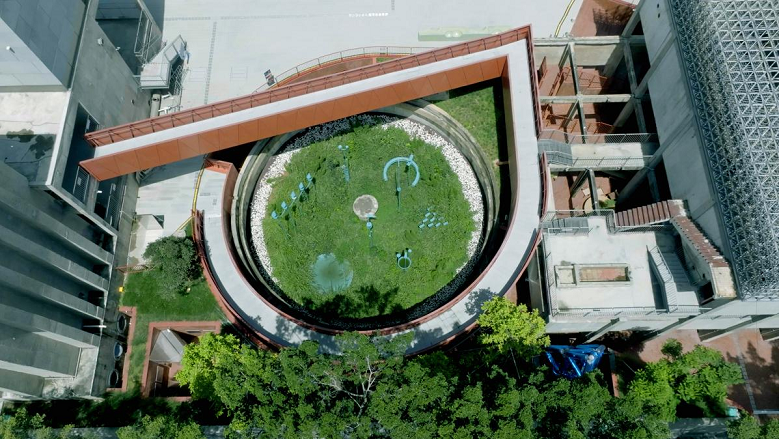
An aerial view of the beer fermenter [Source:Shenzhen Urban Planning and Design Institute]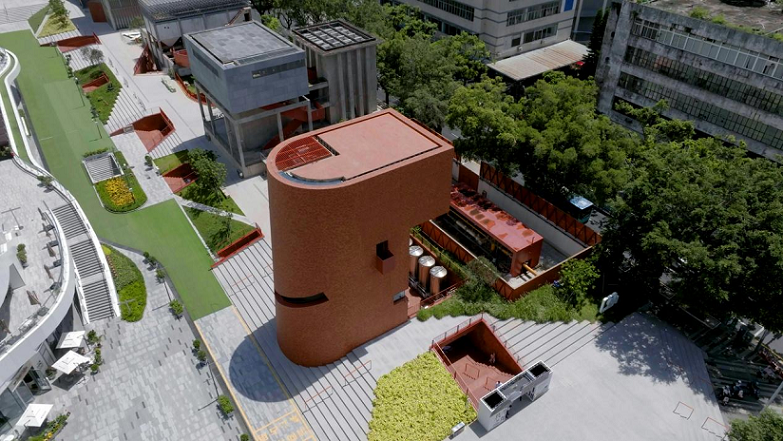
An aerial view of the open space of the site [Source:Shenzhen Urban Planning and Design Institute]
Author:Huang Weidong、Wang Jia、Lin Chenfang、Zhang Daoqiong
Source:<https://mp.weixin.qq.com/s/faqyIO2buUBFYMghqHDCng>
Edited and Translated by Guan Tao